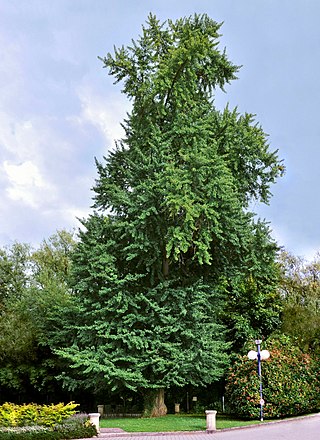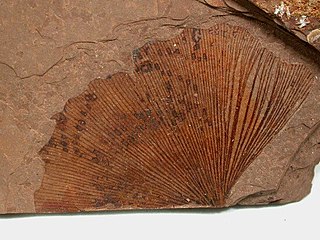
Ginkgo biloba, commonly known as ginkgo or gingko, also known as the maidenhair tree, is a species of gymnosperm tree native to China. It is the last living species in the order Ginkgoales, which first appeared over 290 million years ago. Fossils very similar to the living species, belonging to the genus Ginkgo, extend back to the Middle Jurassic epoch approximately 170 million years ago. The tree was cultivated early in human history and remains commonly planted.

Ginkgoales are a gymnosperm order containing only one extant species: Ginkgo biloba, the ginkgo tree. It is monotypic, within the class Ginkgoopsida, which itself is monotypic within the division Ginkgophyta. The order includes five families, of which only Ginkgoaceae remains extant.

Sinobaatar is a genus of extinct mammal from the Lower Cretaceous of China. It is categorized within the also extinct order Multituberculata and among these it belongs to the plagiaulacid lineage. Sinobaatar was a small herbivore during the Mesozoic era, commonly called "the age of the dinosaurs". The genus was named by Hu Y. and Wang Y. in 2002. Three species have been described.

Gnetophyta is a division of plants, grouped within the gymnosperms, that consists of some 70 species across the three relict genera: Gnetum, Welwitschia, and Ephedra. Fossilized pollen attributed to a close relative of Ephedra has been dated as far back as the Early Cretaceous. Though diverse in the Early Cretaceous, only three families, each containing a single genus, are still alive today. The primary difference between gnetophytes and other gymnosperms is the presence of vessel elements, a system of small tubes (xylem) that transport water within the plant, similar to those found in flowering plants. Because of this, gnetophytes were once thought to be the closest gymnosperm relatives to flowering plants, but more recent molecular studies have brought this hypothesis into question, with many recent phylogenies finding them to be nested within the conifers.

Engelbert Kaempfer from Lemgo was a German naturalist, physician, explorer and writer known for his tour of Russia, Persia, India, Southeast Asia, and Japan between 1683 and 1693.
The Yixian Formation is a geological formation in Jinzhou, Liaoning, People's Republic of China, that spans the late Barremian and early Aptian stages of the Early Cretaceous. It is known for its exquisitely preserved fossils, and is mainly composed of basalts interspersed with siliciclastic sediments.

Yixianosaurus is a maniraptoran theropod dinosaur genus from the Early Cretaceous of China.

Sinusonasus is a genus of dinosaurs from the Early Cretaceous Period, recovered from the Yixian Formation. It lived in what is now the Liaoning Province of China. Sinusonasus was a theropod, specifically a troodontid dinosaur.

Jixiangornis is a genus of basal avialans from the Early Cretaceous. Like later avialans, it had no teeth, but it also had a long tail, unlike modern birds. Since teeth were still present in some more derived short-tailed avialans, Jixiangornis seems to have evolved its toothlessness independently of modern birds. The long forelimb indicates at least some aerial ability. Jixiangornis is currently known only from a single specimen, a complete but juvenile skeleton. The fossil was found in the Yixian Formation near Beipiao City, western Liaoning, China.

Graciliraptor is a genus of theropod dinosaur from the early Cretaceous Period. It is a microraptorine dromaeosaurid.

Archaeamphora longicervia is a fossil plant species, the only member of the genus Archaeamphora. Fossil material assigned to this taxon originates from the Yixian Formation of northeastern China, dated to the Early Cretaceous.

The Jehol Biota includes all the living organisms – the ecosystem – of northeastern China between 133 and 120 million years ago. This is the Lower Cretaceous ecosystem which left fossils in the Yixian Formation and Jiufotang Formation. These deposits are composed of layers of tephra and sediment. It is also believed to have left fossils in the Sinuiju series of North Korea. The ecosystem in the Lower Cretaceous was dominated by wetlands and numerous lakes. Rainfall was seasonal, alternating between semiarid and mesic conditions. The climate was temperate. The Jehol ecosystem was interrupted periodically by ash eruptions from volcanoes to the west. The word "Jehol" is a historical transcription of the former Rehe Province.

Ginkgo is a genus of non-flowering seed plants. The scientific name is also used as the English name. The order to which it belongs, Ginkgoales, first appeared in the Permian, 270 million years ago, and Ginkgo is now the only living genus within the order. The rate of evolution within the genus has been slow, and almost all its species had become extinct by the end of the Pliocene. The sole surviving species, Ginkgo biloba is only found in the wild in China, but is cultivated around the world. The relationships between ginkgos and other groups of plants are not fully resolved.
Eobelinae are an extinct weevil subfamily that throve in the late Mesozoic. They belong to the family Nemonychidae. The Eobelidae were widespread, occurring at least in Central Asia, Spain and Brazil during the Late Jurassic and Early Cretaceous.

The Tiaojishan Formation is a geological formation in Hebei and Liaoning, People's Republic of China, dating to the middle-late Jurassic period. It is known for its exceptionally preserved fossils, including those of plants, insects and vertebrates. It is made up mainly of pyroclastic rock interspersed with basic volcanic and sedimentary rocks. Previously, the Tiaojishan Formation was grouped together with the underlying Haifanggou Formation as a single "Lanqi Formation." The Tiaojishan Formation forms a key part of the Yanliao Biota assemblage, alongside the Haifanggou Formation.
The Haifanggou Formation, also known as the Jiulongshan Formation, is a fossil-bearing rock deposit located near Daohugou village of Ningcheng County, in Inner Mongolia, northeastern China.

Ginkgotoxin (4'-O-methylpyridoxine) is a neurotoxin naturally occurring in Ginkgo biloba. It is an antivitamin structurally related to vitamin B6 (pyridoxine). It has the capacity to induce epileptic seizures.

Ginkgo huttonii is an extinct Ginkgo species in the family Ginkgoaceae from the Jurassic of England. The fossil is also known by the name, Ginkgoites huttonii, the genus, Ginkgoites, referring to a group of extinct members of the Ginkgoaceae. G. huttonii was a broad-leaved, deciduous gymnosperm bearing resemblance to the only living member of the Ginkgoaceae, Ginkgo biloba.

Ginkgo yimaensis is an extinct ginkgo species in the family Ginkgoaceae. It is a gymnosperm, first described by Zhou and Zhang.

Anchiornithidae is a family of eumaniraptorans which could be the basalmost family of birds in the clade Avialae. Anchiornithids have been classified at varying positions in the maniraptoran tree, with some scientists classifying them as a distinct family, a basal subfamily of Troodontidae, members of Archaeopterygidae, or an assemblage of dinosaurs that are an evolutionary grade within Avialae or Paraves.

















